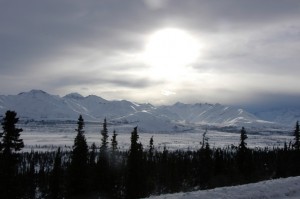
Northern Warfare Training Center tests troops’ mettle in harshest conditions
BLACK RAPIDS, Alaska — Trying to shoot straight in combat is tough even under the best conditions. Add in mountainous terrain, and the degree of difficulty jumps dramatically.
Mountain marksmanship ranges at the Army’s Northern Warfare Training Center are set up so that troops can practice engaging the enemy in a steep and complex landscape.
“It was designed for troops going to Afghanistan,” said the school’s commandant, Lt. Col. Mark Adams, 45, of West Farmington, Ohio. “When you are shooting on a horizontal range, things are pretty simple. Here you are shooting at steep angles up and down.”
First established 67 years ago, at the dawn of the long standoff with the Soviet Union, the training center remains just as relevant today, as the Army and Marines ramp up cold-weather training amid tensions in Eastern Europe, disputes over arctic resources and instability on the Korean Peninsula.
Essentially, the military is relearning skills that were at a premium during the Cold War.
Troops come to the Army’s Black Rapids Training Site, a mountainous area deep in the Alaskan interior, to learn how to fight and survive in some of the harshest weather on Earth. The school’s 15 instructors and 35 support personnel run a range of courses, mostly for soldiers stationed in Alaska, who earn the coveted “Arctic” uniform tab once they have completed the program.
“We have the extremes here, so it makes the training very realistic,” Adams said on a recent, typical February day, when temperatures in the short daylight hours hovered around minus 30 Fahrenheit before plunging another 20 degrees at night.
The school has trained West Point cadets, Navy SEALs, Army Rangers and FBI agents, but most of its students are assigned to U.S. Army Alaska’s two infantry brigades — the 1st Stryker Brigade Combat Team out of Fort Wainwright and the 4th Brigade Combat Team (Airborne) out of Fort Richardson.
“They have to get the basics because back at their units, they train in these temperatures,” Adams said of the Alaska-based troops.
The NWTC was established in 1948. Originally based at Camp Hale, Colo., the school — now headquartered at Fort Wainwright — moved to Alaska in 1956.
The barracks at Black Rapids are full of old photographs and keepsakes depicting the school’s history.
There’s a “Life” magazine cover art of an ice-axe wielding “mountain trooper” from 1942, pictures of Gen. William Westmoreland — former commander of U.S. forces in Vietnam — visiting the area, photos of soldiers summiting Mount McKinley and pieces of ancient ski and mountaineering equipment.
Memorials at the school serve as a reminder that operating in such a harsh environment can be deadly.
In 1987, two soldiers died in training accidents near Black Rapids. West Point Cadet John Kilfeather had a fatal fall into a crevasse on the Gulkana Glacier, and Staff Sgt. Andy Silver was killed crossing Phelan Creek, As recently as December, instructors from the school rushed to help a local back-country skier. The man, from the nearby town of Delta Junction, had been caught in an avalanche that killed his skiing partner.
“This is a very unforgiving time of year,” Adams said as a group of his soldiers prepared to venture outdoors to practice cross-country skiing.
Some of the training is as simple as teaching people how to dress properly to survive in the arctic, he said.
The Army provides troops with insulated jackets and pants. If somebody goes outside in extreme weather wearing a facemask, it’s better not to take it off because the moisture inside will freeze to their face. Heavy winter mittens are worn over insulating gloves to protect fingers from frostbite, and soldiers are told to dress in layers and wear moisture-wicking materials close to the skin.
“We tell the soldiers to teach some of this stuff to their kids,” Adams said, noting that the Alaskan soldiers’ families also face pretty harsh conditions in Fairbanks during winter.
Despite the precautions, troops have suffered frostbite and trench foot during training at Black Rapids in recent years, he said.
Missile-defense silos at nearby Fort Greely are a reminder of threats to the homeland, even in this desolate outpost. The Alyeska pipeline — which carries oil 800 miles from Prudhoe Bay in the far north to the port of Valdez — passes under the ranges at Black Rapids; evidence of the strategic importance of arctic resources.
Increased interest in those riches from the likes of Russia, along with potential for contingencies in cold parts of Europe and on the Korean peninsula, mean demand for cold weather training is picking up. Last year, the school trained 1,300 personnel, Adams said.
The school has a fleet of snowmobiles and six SUSVs (small unit support vehicles) for moving people and supplies around in the snow, but the school’s focus is dismounted soldier skills.
“We focus on cold weather training in winter and mountaineering and assault climbing in summer,” Adams said.
Read the full article: Stripes





Leave a Reply